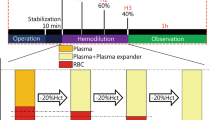Abstract
The rational choice of a plasma substitute for states of hypovolaemia depends partly on its colloid osmotic pressure (COP). We have measured the COP of 108 samples of plasma substitute across selectively permeable membranes which retain molecules greater than 10000 dalton (COP10) and 50000 dalton (COP50) the ratio COP50/COP10 providing a potential index of diffusibility of the smaller molecules across capillary membranes. 6% Hespan solution showed a particularly favourable COP50/COP10 ratio at 0.58 indicating a potential for good retention in the circulation whilst 3.5% Haemaccel showed a COP50/COP10 ratio of 0.18 indicating a potential for marked transcapillary diffusion, especially in states of capillary leak. In patients with normal capillary permeability both Gelofusine and Dextran 110 are likely to show adequate retention in the circulation with a COP50/COP10 ratio of 0.37 and 0.39 respectively. These are comparable to the retention of 4.5% human albumin (0.36) but all of the plasma substitutes tested, with the exception of Haemaccel, provided a higher COP across both membranes than 4.5% human albumin solution. An in vivo comparison of these plasma substitutes is required to confirm the advantages of macromolecular colloids in states of capillary leak.
Similar content being viewed by others
References
Haupt MT, Rackow EC (1982) Colloid osmotic pressure and fluid resuscitation with hetastarch, albumin, and saline solutions. Crit Care Med 10:159
Mudge GH (1985) Agents affecting volume and composition of body fluids. In: Goodman LS, Gilman A (eds) The Pharmacological basis of Therapeutics, 7th edn. Bailliere Tindall, London, p 846
Yamasaki H (1973) The colloid osmotic pressure of normal human blood, Dextran and Hydroxyethyl starch. Jpn Anaesthesiol 22:1349
Barclay SA (1987) Colloid osmotic pressure: its measurement and role in clinical cardiovascular medicine. PhD thesis, University of London
Grotte G (1956) Passage of dextran molecules across the blood lympth barrier. Acta Chir Scand 211 [Suppl]:1
Landis EM, Pappenhimer JR (1963) Exchange of substances through capillary walls. In: Handbook of Physiology. Circulation, Vol 2, sect 2, chapt 29. American Physiological Society, Washington DC, p 961
Taylor AE, Gaar KA (1970) Estimation of equivalent pore radii of pulmonary capillary and alveolar membranes. Am J Physiol 218:1133
Michel CC (1984) Fluid movements through capillary walls. In: Handbook of Physiology. Cardiovascular System IV, Chapt 9. American Physiological Society, Washington DC, p 375
Sibbald W, Driedger A, Wells G, Myers ML, Sefcoe M (1983) The short term effects of incrasing plasma COP in patients with noncardiac pulmonary oedema. Surgery 93:620
Meteldi LS, Shackford SR, Virgilio RW, Peters RM (1984) Crystalloid versus colloid in fluid reuscitation of patients with severe pulmonary insufficiency. Surg Gynaecol, Obstet 158:207
Mishler J (1984) Synthetic plasma volume expanders — Their pharmacology, safety and clinical efficacy. Clin Haematol 13:75
Lindlad G, Falk K (1976) Konzentrationsverlauf von Hydroxyäthylstärke und Dextran in Serum and Lebergewebe von Kaninchen und die histopathologischen Folgen der Speicherung von Hydroxyathylstarke. Infusionstherapie 3:301
Hedin H, Richter W, Messmer K, Renck M, Tjungström RG, Taubenthal M (1981) Incidence, pathomechanism and prevention of dextran induced anaphylacticoid/anaphylactic reactions in man. Dev Biol Stand 48:179
Ring J, Messner K (1977) Incidence and sevverity of anaphylacticoid reactions to colloid volume substitutes. Lancet I:466
Ring J, Richter W (1980) Wirkungsmechanismus unerwünschter Reaktionen nach Hydroxyäthylstärke und Humanalbumin. Allergologie 3:79
Weis KH (1983) Haemaccel 35: nebenreaktionen in einer multizentrischen, prospectiven Studie. Anaesthetist 32:488
Author information
Authors and Affiliations
Rights and permissions
About this article
Cite this article
Webb, A.R., Barclay, S.A. & Bennett, E.D. In vitro colloid osmotic pressure of commonly used plasma expanders and substitutes: a study of the diffusibility of colloid molecules. Intensive Care Med 15, 116–120 (1989). https://doi.org/10.1007/BF00295988
Received:
Accepted:
Issue Date:
DOI: https://doi.org/10.1007/BF00295988




